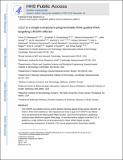| dc.contributor.author | Shmakov, S. | |
| dc.contributor.author | Makarova, K. S. | |
| dc.contributor.author | Semenova, E. | |
| dc.contributor.author | Minakhin, L. | |
| dc.contributor.author | Severinov, K. | |
| dc.contributor.author | Koonin, E. V. | |
| dc.contributor.author | Regev, Aviv | |
| dc.contributor.author | Gootenberg, Jonathan S | |
| dc.contributor.author | Konermann, Silvana M | |
| dc.contributor.author | Joung, Julia | |
| dc.contributor.author | Slaymaker, Ian | |
| dc.contributor.author | Cox, David Benjamin Turitz | |
| dc.contributor.author | Lander, Eric Steven | |
| dc.contributor.author | Zhang, Feng | |
| dc.contributor.author | Abudayyeh, Omar O. | |
| dc.date.accessioned | 2016-12-09T20:58:39Z | |
| dc.date.available | 2016-12-09T20:58:39Z | |
| dc.date.issued | 2016-08 | |
| dc.date.submitted | 2016-03 | |
| dc.identifier.issn | 0036-8075 | |
| dc.identifier.issn | 1095-9203 | |
| dc.identifier.uri | http://hdl.handle.net/1721.1/105791 | |
| dc.description.abstract | The clustered regularly interspaced short palindromic repeat (CRISPR)–CRISPR-associated genes (Cas) adaptive immune system defends microbes against foreign genetic elements via DNA or RNA-DNA interference. We characterize the class 2 type VI CRISPR-Cas effector C2c2 and demonstrate its RNA-guided ribonuclease function. C2c2 from the bacterium Leptotrichia shahii provides interference against RNA phage. In vitro biochemical analysis shows that C2c2 is guided by a single CRISPR RNA and can be programmed to cleave single-stranded RNA targets carrying complementary protospacers. In bacteria, C2c2 can be programmed to knock down specific mRNAs. Cleavage is mediated by catalytic residues in the two conserved Higher Eukaryotes and Prokaryotes Nucleotide-binding (HEPN) domains, mutations of which generate catalytically inactive RNA-binding proteins. These results broaden our understanding of CRISPR-Cas systems and suggest that C2c2 can be used to develop new RNA-targeting tools. | en_US |
| dc.description.sponsorship | United States. Dept. of Energy (Computational Science Graduate Fellowship) | en_US |
| dc.description.sponsorship | Massachusetts Institute of Technology. Simons Center for the Social Brain | en_US |
| dc.description.sponsorship | National Institute of General Medical Sciences (U.S.) (Award T32GM007753) | en_US |
| dc.description.sponsorship | National Institutes of Health (U.S.) (National Institute of Mental Health (U.S.) Grants 5DP1-MH100706 and 1R01-MH110049) | en_US |
| dc.description.sponsorship | National Science Foundation (U.S.) | en_US |
| dc.description.sponsorship | New York Stem Cell Foundation | en_US |
| dc.description.sponsorship | Simons Foundation | en_US |
| dc.description.sponsorship | Paul G. Allen Family Foundation | en_US |
| dc.description.sponsorship | Vallee Foundation | en_US |
| dc.description.sponsorship | Poitras Foundation | en_US |
| dc.description.sponsorship | Robert Metcalfe | en_US |
| dc.description.sponsorship | David R. Cheng | en_US |
| dc.language.iso | en_US | |
| dc.publisher | American Association for the Advancement of Science (AAAS) | en_US |
| dc.relation.isversionof | http://dx.doi.org/10.1126/science.aaf5573 | en_US |
| dc.rights | Article is made available in accordance with the publisher's policy and may be subject to US copyright law. Please refer to the publisher's site for terms of use. | en_US |
| dc.source | PMC | en_US |
| dc.title | C2c2 is a single-component programmable RNA-guided RNA-targeting CRISPR effector | en_US |
| dc.type | Article | en_US |
| dc.identifier.citation | Abudayyeh, O. O. et al. “C2c2 Is a Single-Component Programmable RNA-Guided RNA-Targeting CRISPR Effector.” Science 353.6299 (2016): aaf5573-aaf5573. | en_US |
| dc.contributor.department | Harvard University--MIT Division of Health Sciences and Technology | en_US |
| dc.contributor.department | Massachusetts Institute of Technology. Department of Biological Engineering | en_US |
| dc.contributor.department | Massachusetts Institute of Technology. Department of Biology | en_US |
| dc.contributor.department | Massachusetts Institute of Technology. Department of Brain and Cognitive Sciences | en_US |
| dc.contributor.department | McGovern Institute for Brain Research at MIT | en_US |
| dc.contributor.mitauthor | Regev, Aviv | |
| dc.contributor.mitauthor | Abudayyeh, Omar Osama | |
| dc.contributor.mitauthor | Gootenberg, Jonathan S | |
| dc.contributor.mitauthor | Konermann, Silvana M | |
| dc.contributor.mitauthor | Joung, Julia | |
| dc.contributor.mitauthor | Slaymaker, Ian | |
| dc.contributor.mitauthor | Cox, David Benjamin Turitz | |
| dc.contributor.mitauthor | Lander, Eric Steven | |
| dc.contributor.mitauthor | Zhang, Feng | |
| dc.relation.journal | Science | en_US |
| dc.eprint.version | Author's final manuscript | en_US |
| dc.type.uri | http://purl.org/eprint/type/JournalArticle | en_US |
| eprint.status | http://purl.org/eprint/status/PeerReviewed | en_US |
| dspace.orderedauthors | Abudayyeh, O. O.; Gootenberg, J. S.; Konermann, S.; Joung, J.; Slaymaker, I. M.; Cox, D. B. T.; Shmakov, S.; Makarova, K. S.; Semenova, E.; Minakhin, L.; Severinov, K.; Regev, A.; Lander, E. S.; Koonin, E. V.; Zhang, F. | en_US |
| dspace.embargo.terms | N | en_US |
| dc.identifier.orcid | https://orcid.org/0000-0001-8567-2049 | |
| dc.identifier.orcid | https://orcid.org/0000-0002-7979-3220 | |
| dc.identifier.orcid | https://orcid.org/0000-0001-7915-1685 | |
| dc.identifier.orcid | https://orcid.org/0000-0001-6656-5002 | |
| dc.identifier.orcid | https://orcid.org/0000-0001-8794-2137 | |
| dc.identifier.orcid | https://orcid.org/0000-0001-7626-4254 | |
| dc.identifier.orcid | https://orcid.org/0000-0003-2782-2509 | |
| mit.license | PUBLISHER_POLICY | en_US |
